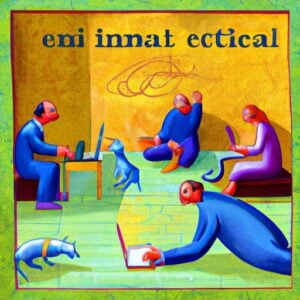Why learn how to write a letter in Italian?
Learning how to write a letter in Italian holds significant value as it opens a door to effective communication in both personal and professional spheres. Mastering this skill not only enhances language proficiency but also cultivates cultural understanding and appreciation.
Moreover, it strengthens one’s ability to navigate various contexts, such as job applications, formal invitations, expressing gratitude, or maintaining personal correspondence, thereby fostering meaningful connections with Italian speakers while showcasing respect for traditions and etiquettes inherent in Italian communication.
How To Write An Email In Italian – Step-By-Step Guide
Step 1: How to Write the Subject of an Email
The first thing you need to keep in mind is that an email is a text with a structure.
If you organize it into short paragraphs and you use the right opening and closing formulas, you are already halfway there.
Writing (and reading) an email doesn’t actually start with the email itself. Have you ever noticed?
It starts with the subject you read before even opening the message!
So remember, never overlook the subject of an email! It is an essential part of every communication, and it will be the first thing the recipient sees and reads.
If badly written or absent, it could get no attention, give a bad impression or worse, make your email look like spam! And you do not want your message to go straight to the bin, do you?
So, be clear and concise and explain in a few words the reason why you’re writing.
Step 2: Opening Greetings and Titles
Informal Emails
The opening greetings (formula di apertura) can change a lot depending on who you are writing to. If you are addressing a friend or someone you know well, you can use the following words:
Caro/Cara
Dear
Ciao
Hi
It is becoming increasingly common to start emails with simple greetings like:
Buongiorno
Good morning/afternoon
Buonasera
Good evening
These can be considered a middle ground between a very informal Ciao and the more formal addressing Gentile and are a great go-to when you don’t know the reader’s name or gender!
Formal Emails
If you do not know the person you’re writing to, for example, when you ask for information or for a job application, you can use adjectives like gentile or egregio/ egregia followed by either:
- the title* of the person you are addressing,
- or the abbreviation Sig. (Signore – Mr.) or Sig.ra (Signora – Mrs.) followed by their surname.
Gentile direttore/ Gentile insegnante
Dear director/ Dear teacher
Gentile Sig. Bellini / Gentile Sig.ra Bellini
Dear Mr. Bellini / Dear Mrs. Bellini
Gentile (lit. kind, gentle) is a slightly more formal version of “caro/cara” and is widely used in all sectors.
Egregio direttore/ Egregio professore / Egregia professoressa
Dear director/ Dear teacher
Egregio Sig. Bellini/ Egregia Sig.ra Bellini
Dear Mr. Bellini / Dear Mrs. Bellini
These are very formal and are mainly found in official communication.
Remember to pay attention to the gender agreement!
With the name of a business, use Spettabile (Respectable). For example: Spettabile Scuola di Italiano.
*Italians love their titles, so it is important to mention them, even in an email! If the addressee has a title you know of, use these abbreviations:
Dott. / Dot.ssa (dottore / dottoressa)
a doctor or anyone with a degree
Avv. (avvocato)
lawyer
Ing. (ingegnere)
engineer
Arch. (architetto)
architect
Rag. (ragioniere)
accountant
Step 3: Write the Opening — Greeting and Introduction
Here are the Common Phrases to Use for Introduction in informal emails.
At this point, you can introduce yourself:
Sono Michael.
I’m Michael.
Mi chiamo Allison Bay.
My name is Allison Bay.
Mi chiamo Robert Nash e sono un ingegnere elettronico.
My name is Robert Nash, and I’m an electronic engineer.
Then, if you’re writing an informal email, you can thank the other person for their previous correspondence:
Grazie per la tua/sua email.
Thanks for your email.
Ti/La ringrazio per avermi scritto.
Thank you for writing to me.
Or apologize:
Scusa/Scusi se non ho risposto prima, ero molto impegnato/a.
I’m sorry I didn’t answer before; I was very busy.
Tua, ti, and scusa are informal, whereas sua, la, and scusi are formal.
Informal email
If, on the other hand, you’re writing a more formal message, after introducing yourself (if you want and it is required by the context) make a short point on why you are writing and/or what you are writing about.
You can use the following phrases:
Le scrivo in riferimento al nostro incontro.
I am writing with regard to our meeting
Le scrivo in riferimento al colloquio telefonico.
I am writing with regard to our phone call
Come anticipato nella mail precedente/telefonicamente.
As stated in the previous mail/call
In risposta alla Sua mail…
Answering your email…
Body
Then comes the body, which is the main part of your email. Here you can explain your reason for writing in more detail.
In an informal letter, just write what you want; this is the time for open communication!
In a formal context, you can say:
Con la presente comunico…
I am writing with regard to…
Le scrivo perché vorrei delle informazioni su…
I am writing because I would like some information about…
Con la presente, scrivo per presentare la mia candidatura per il posto di (job position) presso (company)
I am writing to apply for the job (position) at (company)…
And remember, if you have an attachment, don’t forget to mention it!
In allegato invio…
Please find attached…
Allego…
I am attaching
Step 4: Conclusion and Closing Greetings
Here’s how to sign off or end a formal letter in Italian.
To conclude a formal communication, use one of the following formulas.
They all stand for the English “I am looking forward to hearing from you,” and even if they have slightly different literal meanings, they all serve the same purpose.
- In attesa di riscontro, resto a disposizione per chiarimenti e porgo cordiali saluti.
- In attesa di un Suo cortese riscontro
- Ringraziando per l’attenzione
Followed by one of these Italian formal salutations or formule di congedo, which stands for the English sincerely or warm regards.
- Distinti Saluti
- Cordiali Saluti
- Cordialmente
How to sign off or end an informal letter in Italian?
In an informal conclusion, you can just end the email with something like:
Fammisapere
Let me know
Unabbraccio
A hug
A presto
See you/Write soon
How to write a formal or business letter in Italian?
When composing a formal or business letter in Italian, adhering to specific conventions is crucial. Begin with the recipient’s full name, title, and address, followed by your information. Start with a polite salutation like “Gentile Signore” (Dear Sir) or “Egregio Professore” (Dear Professor). Introduce yourself briefly and concisely state the purpose of your letter.
Maintain a respectful and courteous tone throughout, using formal language and avoiding contractions.
Clearly articulate your points, providing necessary details and supporting information. Conclude with a formal closing phrase such as “Distinti saluti” (Yours sincerely) or “Cordiali saluti” (Kind regards), followed by your name, position, and contact information.
Maintain a clear and organized structure, ensuring the letter is properly formatted and free from spelling or grammatical errors before sending it. Following these conventions ensures professionalism and clarity in your formal or business correspondence in Italian.
Formal Email Vocabulary
- Salutations:
- Gentile Signore / Gentile Signora (Dear Sir / Dear Madam)
- Egregio / Egregia (Dear [Formal, used with surnames])
- Opening Phrases:
- Mi permetta di presentarmi… (Allow me to introduce myself…)
- Con riferimento a… (With reference to…)
- In merito alla nostra precedente conversazione… (Regarding our previous conversation…)
- Requesting Information:
- Gradirei ricevere ulteriori informazioni riguardo a… (I would like to receive further information regarding…)
- Sarebbe possibile…? (Would it be possible…?)
- La ringrazio anticipatamente per la sua cortese attenzione. (Thank you in advance for your kind attention.)
- Offering Help:
- Sono a disposizione per ulteriori chiarimenti. (I am available for further clarification.)
- Se posso esserle di aiuto in qualche modo… (If I can be of help in any way…)
- Closing Phrases:
- Resto in attesa di un suo gentile riscontro. (I look forward to your kind response.)
- Cordiali saluti, (Kind regards,)
- Distinti saluti, (Yours sincerely,)
Informal Email Vocabulary
- Salutations:
- Ciao / Salve (Hi / Hello)
- Caro / Cara (Dear [used with first names])
- Opening Phrases:
- Spero che tu stia bene. (I hope you’re doing well.)
- Come va? (How are you?)
- Ti scrivo per… (I’m writing to you about…)
- Requesting Information:
- Potresti darmi qualche informazione su…? (Could you give me some information about…?)
- Avresti la gentilezza di…? (Would you be so kind as to…?)
- Grazie in anticipo per il tuo aiuto. (Thanks in advance for your help.)
- Offering Help:
- Se hai bisogno di qualcosa, sono qui. (If you need anything, I’m here.)
- Fammi sapere se posso esserti utile in qualche modo. (Let me know if I can be helpful in any way.)
- Closing Phrases:
- A presto, (See you soon,)
- Un abbraccio, (Hugs,)
- Tanti saluti, (Best regards,)
Remember, the tone and language choice should match the context and relationship with the recipient when composing both formal and informal emails.
Here’s an informal email in Italian along with its English translation:
Example of a friendly email in Italian
Italian:
Ciao Maria,
Spero che tu stia bene! Volevo solo scriverti per ringraziarti ancora per il fantastico pranzo di sabato scorso. Le tue abilità culinarie sono davvero straordinarie! È stato così bello passare del tempo insieme e gustare quelle prelibatezze italiane autentiche.
Ho pensato che potremmo pianificare un’altra serata del genere presto. Magari possiamo organizzare una cena a casa mia e cucinare insieme qualche piatto italiano. Che ne dici?
Fammi sapere se sei disponibile e possiamo fissare una data. Non vedo l’ora di ripetere questa esperienza!
Un abbraccio, Luca
English translation:
Hi Maria,
I hope you’re doing well! I just wanted to write and thank you again for the fantastic lunch last Saturday. Your culinary skills are truly extraordinary! It was so nice to spend time together and savor those authentic Italian delicacies.
I thought we could plan another evening like that soon. Maybe we could arrange a dinner at my place and cook some Italian dishes together. What do you think?
Let me know if you’re available, and we can set a date. I can’t wait to repeat this experience!
Hugs, Luca
Example of a Formal Email in Italian
Here’s an example of a formal email in Italian:
Oggetto: Richiesta di Informazioni sul Progetto di Collaborazione
Gentile [Nome Destinatario],
Mi chiamo [Tuo Nome] e sono [La tua posizione o affiliamento, se necessario] presso [Nome della tua azienda o istituzione]. Scrivo per richiedere ulteriori informazioni riguardo al progetto di collaborazione menzionato durante l’ultima conferenza tenutasi a [Luogo] il [Data].
Sarei molto interessato/a a comprendere meglio i dettagli del progetto, inclusi gli obiettivi, le tempistiche e le eventuali opportunità di coinvolgimento. Gradirei inoltre sapere se è previsto un incontro o una presentazione dettagliata per discutere approfonditamente i termini e le modalità di questa collaborazione.
Sono disponibile per un incontro telefonico o una riunione di persona, in base alla vostra convenienza. Vi prego di farmi sapere se è possibile organizzare un appuntamento al fine di discutere in dettaglio questa prospettiva di collaborazione.
Resto in attesa di un vostro cortese riscontro e vi ringrazio anticipatamente per l’attenzione che vorrete dedicare alla mia richiesta.
Cordiali saluti,
[Tuo Nome] [Tua Posizione] [Nome della Tua Azienda o Istituzione] [Contatti: Indirizzo email e numero di telefono]
Subject: Request for Information Regarding Collaboration Project
English Translation
Dear [Recipient’s Name],
My name is [Your Name], and I am [Your Position or Affiliation, if necessary] at [Your Company or Institution’s Name]. I am writing to request further information regarding the collaboration project mentioned during the last conference held in [Location] on [Date].
I am very interested in gaining a better understanding of the project details, including the objectives, timelines, and any potential opportunities for involvement. Additionally, I would like to inquire if there is a scheduled meeting or a detailed presentation to thoroughly discuss the terms and modalities of this collaboration.
I am available for a phone call or an in-person meeting, according to your convenience. Please let me know if it is possible to arrange an appointment to discuss this collaboration prospect in detail.
I am looking forward to your kind response and thank you in advance for considering my request.
Best regards,
[Your Name] [Your Position] [Your Company or Institution’s Name] [Contact Information: Email Address and Phone Number]
Want to practice
Write an email in Italian today!
Who will be the lucky one to receive an email in Italian from you?
A friend? A colleague? A relative? A lover?
There’s a lot to write about. Can you put it in writing now?
In any case, writing an email is an excellent way to practice your writing skills. Don’t worry about minor mistakes. It’s not an exam. You want to communicate.
Happy writing!
Willing to take your Italian to the next level. Try our Italian online course for free.



















